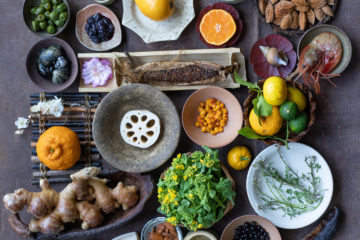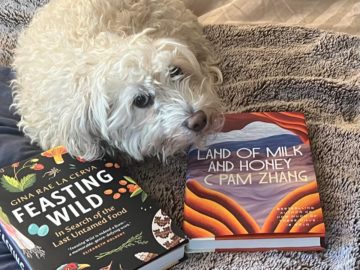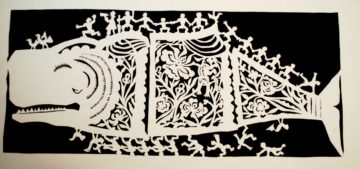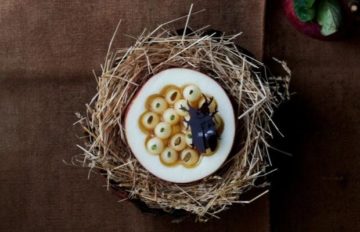by Leanne Ogasawara

1.
In C. Pam Zhang’s new novel Land of Milk and Honey, an agricultural disaster in the Midwest sends clouds of particulates into the atmosphere. Like nuclear winter, the toxic smog suffocates 95% of the plant and animal species on the planet. Famine and societal collapse soon follow~~ and not surprisingly, the super-wealthy start making plans. The fat cat in the novel begins by buying a beautiful mountaintop in Italy where there’s still some sunshine because it’s up that high above the smog. And in this beautiful place, he and his daughter start cultivating animals and precious seeds in underground farms and orchards.
His end game involves luring investors with extravagant multi-course tasting menus, where the finest wines are served alongside truffle risotto and the finest Kobe beef steak, long disappeared from the rest of the world, which is surviving (barely) on a mung bean-derived protein.
“What it amounted to was skies that were gray and kitchens that were gray. You could taste it: gray. No olives, no quails, no grapes of the tart green kind … no saffron, no buffalo, no polished short-grain rice.”
So, what is a young American chef to do?
Her longing for sunshine and pistachios is so great she talks her way into the chef job for the fat cat on his mountaintop.
 2.
2.
Zhang, whose debut novel, How Much of These Hills Is Gold, was a finalist for a Lambda Literary Award and long listed for the 2020 Booker Prize, wrote the Land of Milk and Honey during the early days of the pandemic. It is therefore not surprising that it is composed in a sensual and expansive style– from the perspective of a deep longing for what has been lost.
Like others around me, I stocked our cabinets till they were bursting with Japanese rice and long-grain for paella, pasta and noodles. Canned tomatoes and jars and jars of capers and olives, anchovies and sardines. I have never been a big box shopper and don’t belong to Costco, preferring to buy fresh on more of a daily basis, and so this was a strange experience that that brought it home, the meaning of “sheltering in place.”
As if inequality was not already bad enough in our country, we really did watch as the rich kept getting richer. You could feel it in real estate prices. But also there were many TV shows that came out of the covid years like White Lotus, Billions and Succession which showed the excess of the wealthy—move over Roman senators in their vomitoria, because we now watched the wealthy devouring wildly expensive songbirds, whole under white “shrouds” (to hide their sin of doing harm to the birds or to amp up the experience by depriving the other senses…?) I later learned that to prepare the ortolans for eating, they are kept in dark cages (or sometimes blinded) and force-fed millet to fatten them up like geese for fois gras before being drowned in Armagnac.
This practice was mentioned back in 1998 in an essay by Michael Paterniti in Esquire called “The Last Meal,” which described a dinner enjoyed by dying President François Mitterand, who was said to have “gorged on Marennes oysters, foie gras, capon, and then not one, but two ortolans, in full Armagnac-and-napkin-shroud regalia. He died eight days later, apparently without another morsel having passed his lips.”
You can’t make this stuff up.
Scenes of the super wealthy crunching on the bones of oily songbirds shrouded in white napkins appeared in not one Covid-era TV show but two: the Billions and Succession.

3.
When does the joy and celebration of pleasure turn into gluttony?
Or as Roxane Gay asked in her Audacious book club: Do you think there’s a way to find pleasure in a crumbling world without causing harm?
In the back of the novel, Zhang has written the best acknowledgements section I’ve ever seen, where people who helped her along the way and books that inspired her are drowning amongst the food that nourished her! High and low brow food…. it was fantastic.
Here is her A-C
Appam at Gunpowder, Goa. Baby artichokes hand-picked by Chaz at Frank’s Market, Seattle. Bill Clegg. Bing and da lu mian in my dad’s kitchen. Biologists’ chatter overheard at High Grounds Cafe, Iowa. Blood, Bones & Butter by Gabrielle Hamilton. Brandon Taylor. Brideshead Revisited by Evelyn Waugh. Buddig sliced turkey. Bun rieu at Mau, San Francisco. Burritos at The Hot Shop, Albany. Cabbage with pistachio milk at Mission Chinese, San Francisco. Cannelés at La Boulange, San Francisco. Capri indigos. Chicken McNuggets at McDonald’s. Chili cheese fries at Wienerschnitzel, Salinas. Chip butties at The Trailer of Life, Cambridge. Chocolate pudding at KFC buffets. “CRISPR and the Splice to Survive” by Elizabeth Kolbert.
I started one for my own life! It is just a beginning, but is also a celebration of memory.
I started keeping these kinds of lists many years ago—but this has become more important to me as I have gotten older. I wrote about it here in regard to birding in oil paintings. But this habit has become a way for me to keep track of memories. Maybe this happens to many people when they reach a certain age? But I have started to pay more attention to memories about food. I remember my mother started reminiscing back in her sixties about a pasta her Italian grandfather used to make when she was a little girl. She tried to recreate the pasta and so did I—a short-rib ragu— but nothing hit the mark of memory.
No one tells you that when you grow older, how fraught memories can become. How many more miraculous works of beauty might I see before I die? How many more times to delight in the sound of snow crunching beneath my feet or of the transportive power of a Southern Song dynasty landscape painting. Of traveling inside a painting buffeted by ethers and empty space.
Fireflies and tree frogs.
Or the wonder of bouillabaisse in a restaurant in Marseille. Of sizzling hobo miso wrapped in a leaf and served on a grill at your table in Takayama. Congee at Nightshade in LA or the golden Dorona grape in a wine in Venice, a miracle of seashells and the salt of the lagoon. A few years ago, I had oysters in Anchorage served with a vodka sorbet that made me cry.
In the Land of Milk and Honey, the pleasure of food flirts with gluttony—like eating a resurrected mammoth or hunting down and shooting a golden chimp while children are starving in the streets beneath the mountain enclave, where the story is taking place.
In our own world, we are hunting bluefin tuna to extinction, as a character in the novel says —not only rhinos and elephants; pangolins and green sea turtles. And those oysters in Anchorage were alive when we ate them.

4.
Have you ever crossed a line with food?
Zhang’s novel is in many ways about moral boundaries that are slippery. There is a moral neutrality (or open-endedness) that makes the characters interesting–but each one has their own internal line– for the chef maybe it is the killing of the golden chimp. And perhaps those choices and boundaries are arbitrary and personal to each person.
Like beauty, pleasure has a bad name in our very puritan (judgmental? virtue signaling?) times. I loved the way this book was all about drawing lines… life is about joy and pleasure but when is too much seriously too much? I tried whale whilst in Japan. Just a bite at a work gathering when I didn’t want to make waves and just went along–but since I was a small child, I have loved whales, and it was my first social commitment (I started giving the save the whales campaign my Christmas money as a child). It was only a bite but I have regretted it for almost two decades–felt like I did cross a personal line.
As Bathsheba Demuth writes in her book Floating Coast: An Environmental History of the Bering Strait, “To be alive means taking up our place in a chain of conversions,” This idea that “In order to live, something, some being, is always dying,” is also to ask if there isn’t a meaningful difference between sustainable hunting for subsistence versus industrialized all-out war where the animals are seen as objects for profit? Is it meaningful to distinguish between traditional methods of hunting versus the industrialized food of today? Sustenance versus profit. Sustainable versus greed.
In Erik Hoel’s debut novel Revelation, one of his characters, a neurobiologist postdoc working on consciousness, states that he is a vegetarian at the same time recognizing that his work is dependent on brutal experiments performed on animals. The character mentions other dietary “lines” he has heard his colleagues mentioning. For example, meat consumption based on intelligence. So, chicken yes but no to octopus and pork.
But how about feeding as many human beings as possible? These issues, being bound up with climate disaster and the future of humanity are not things we can continue to brush under the rug as a society—personal predilections and beliefs aside.
5.

That Covid brought about a longing for shared meals and fresh produce (or the fear of missing favorite foods) is natural. But because of early articles about the virus’ connection to wet markets in China, we also saw more books and articles about the good and bad of eating wild.
Foraged and hunted foods became something not only for the poorest in society but also a status symbol among the wealthy.
In Zhang’s novel, as well as in Gina Rae La Cerva’s Feasting Wild: In Search of the Last Untamed Food, the issues are about sustainability as well as recovering something that has been lost. As La Cerva writes, for 95% of human history we foraged and hunted our food. Now, we eat monocrops —she says that 60% of our diet is made up of rice, wheat, and corn. 80% of agricultural crops are annuals and inbred.
Monocrops and industrialized food is the big problem both books seems to argue. We are increasingly having everything in our lives become standardized and under control, and we are certainly creeping toward processed, industrial, bland food.
La Cerva mentions the link between romanticizing the simplicity of wildly hunted and gathered foods to times of excess. Like in the late Roman empire when Horace waxed lyrical about the days of the Republic when men of means did not employ chefs to make elaborate dinners for them, instead saw hunters feasting after the hunt and farmers feasting on grain porridge, ground by the hands of his wife. La Cerva’s book begins in Copenhagen where she dines at the famous restaurant Noma. Considered the #1 restaurant in the world, Noma is celebrated for its sustainably foraged food and healthy fermentation styles. It is also mimicking times of scarcity for the uber-wealthy, says La Cerva.
In Japan, one of my friends, who was living in Beijing and in Tokyo for a conference, invited me to dinner with a prominent political science professor at Tokyo University. My friend didn’t blink an eye when I-Sensei pushed a plate of konawata (“sea cucumber intestines, marinated”) in front of us, and when I refused, he said: “What are you just off the boat?”
I told him, I never do intestines. (I don’t and I won’t).
Seriously, I wanted to add a photo of the dish to this post but didn’t want to disturb. I also drew the line with sushi that was still wriggling on my chopsticks and can’t even watch on TV when people eat live octopus in Korea—tentacles trying to grasp their way out of the mouth of the human apex predator.
But sure enough the next morning I woke up to an email from I-Sensei which ended with a mild scolding: “Food is about adventure!” And he then extemporized a “humble aphorism:”
“A human being is the sum total of everything they have eaten up till that time”…
Now, I ask you: what would Confucius say to that?
Notes
- C Pam Zhang’s Land of Milk and Honey is so much more than what I’ve described here. As I have mentioned before, I am a huge fan of Roxane Gay and love her bookclub at Audacity. And October was devoted to Zhang’s novel. As with all the club reads, Roxane interviews the author on Zoom. Here is a recording of the interview with Zhang. *In the interview, Zhang mentions Duras’ The Lover as a main source. Another favorite writer of mine, Rebecca Sacks wrote a fantastic homage to The Lover this year, called… The Lover! I highly recommend it! Here is a great essay in Lithub she wrote about the writing process.
- Please see my essay in Aeon about memories and birdwatching in oil paintings.
- Another favorite novels of the year (also on Obama’s Summer read list) was Eleanor Cottan’s Birnam Wood. I loved this article in the New Yorker about why Eleanor Cottan wants plot to matter again. This novel also has a billionaire antagonist. A Silicon Valley billionaire is so vile that not only does he buy land in New Zealand for his end-of-days bunker, but he cooks up a plan to become the wealthiest man who ever lived in process. Why do that if the world is ending? Why indeed?
- One of the many things I miss about my life in Japan was the possibility of foraging for mushrooms and fiddle-ferns and of easily going out to pick fruit on farms —the feeling of popping a strawberry just picked off the vine into my mouth or eating oysters and wild seaweed on drives along the coast. I highly recommend Water, Wood, and Wild Things: Learning Craft and Cultivation in a Japanese Mountain Town, by Hannah Kirshner.
- Michael Paterniti (who wrote the haunting article “The Last Meal”) is a favorite writer. See his wonderful book, Driving Mr. Albert: A Trip Across America with Einstein’s Brain. I wrote this essay in these pages a few years ago, Einstein’s Brain.
- Floating Coast: An Environmental History of the Bering Strait by Bathsheba Demuth was the best book I read in nonfiction in 2021. I cannot recommend it enough! Gorgeous writing. Please see my substack for more about this book and eating whale in Japan. And a poem.
- I didn’t love everything about this book on my first read, but it really stuck with me. It is original and interesting: Gina Rae La Cerva’s Feasting Wild: In Search of the Last Untamed Food
- I am a fan of Erik Hoel’s substack. Revelations was his first novel. The Revelations, by Erik Hoel. Here is my 3QD post about octopus minds and consciousness.
- Food: My essay Heaven and Hell in Modena
